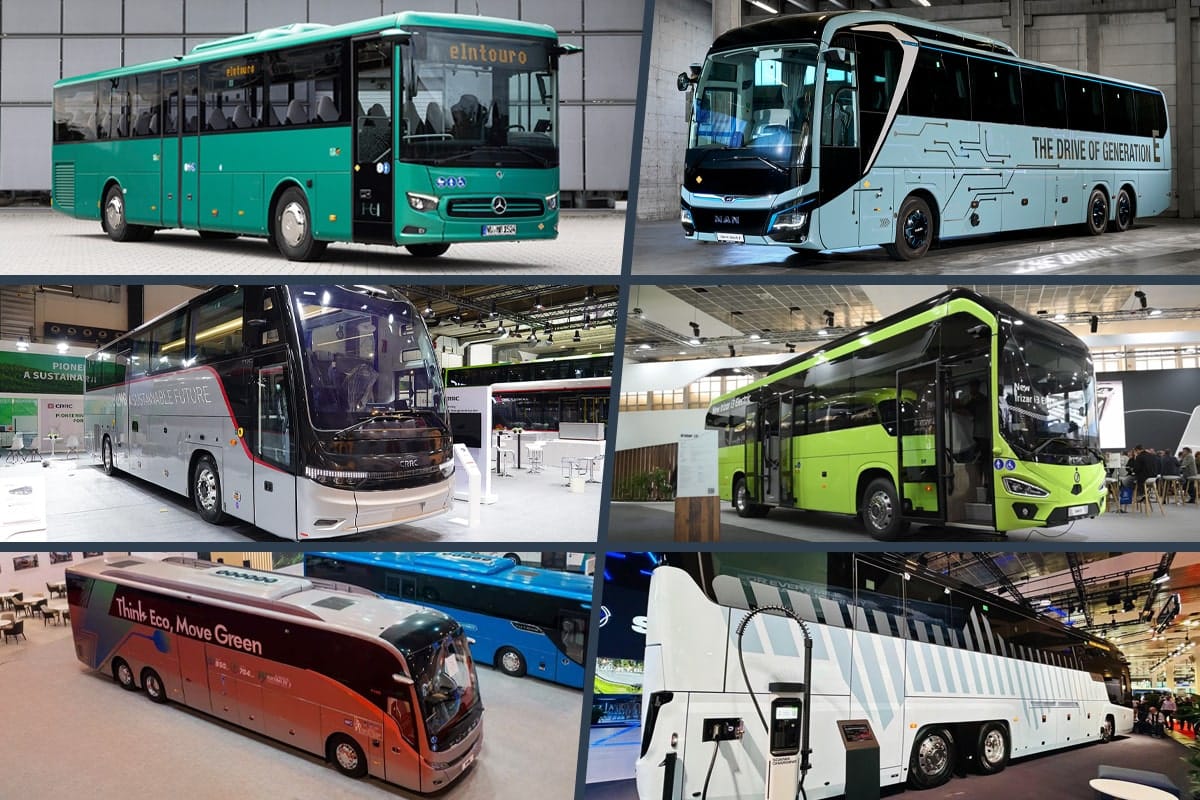
Electricity for ever longer distances: these are the new electric innovations from Busworld
The Busworld trade fair, held every two years in the Belgian capital, is considered the industry’s leading trade fair and thus a barometer of the sector’s current health as well as its near-future prospects. First of all, Busworld continues to grow. The exhibition area has expanded from 75,000 square metres in 2023 to 82,000 square metres. With almost 550 confirmed exhibitors, the trade fair has been fully booked for months. In addition to vehicle manufacturers, system suppliers and component suppliers also maintain a presence. Two years ago, only a few electric buses were to be seen outside of the classic urban public transport sector, but this year the selection has multiplied. Big names such as Daimler Buses, MAN and Scania used the trade fair for world premieres in this segment. At the same time, a whole host of Chinese manufacturers are also launching competing products on the local market.
But first things first: let’s start with Daimler Buses – the Stuttgart-based company has a bestseller in its range with the eCitaro electric city bus. And now they also have an electric intercity bus, according to the statement in Brussels. The manufacturer unveiled the series-production eIntouro there. Thanks to the presentation of a near-series study at the end of 2024 and various test drives, we were already familiar with the model before the trade fair. So here are just the most important points: based on the combustion-engine Intouro, the electric vehicle has a central electric drive with 320 kW continuous power and 400 kW peak power. It comes with up to two 207 kWh batteries, giving it a range of around 500 kilometres, and is related in terms of drive technology to the Mercedes eActros 600 electric long-distance truck. Both vehicles use the same LFP battery with CATL cells.
The first battery pack in the eIntouro is always located in the space behind the front axle, while the optional second battery is located in the former engine compartment at the rear. The batteries can be charged with up to 400 kW charging power for two batteries or up to 225 kW charging power for one battery pack. The new model is available in two lengths: the eIntouro with a length of 12.18 metres and the eIntouro M with a length of 13.09 metres. This allows for seating configurations ranging from 50 to 63 seats.
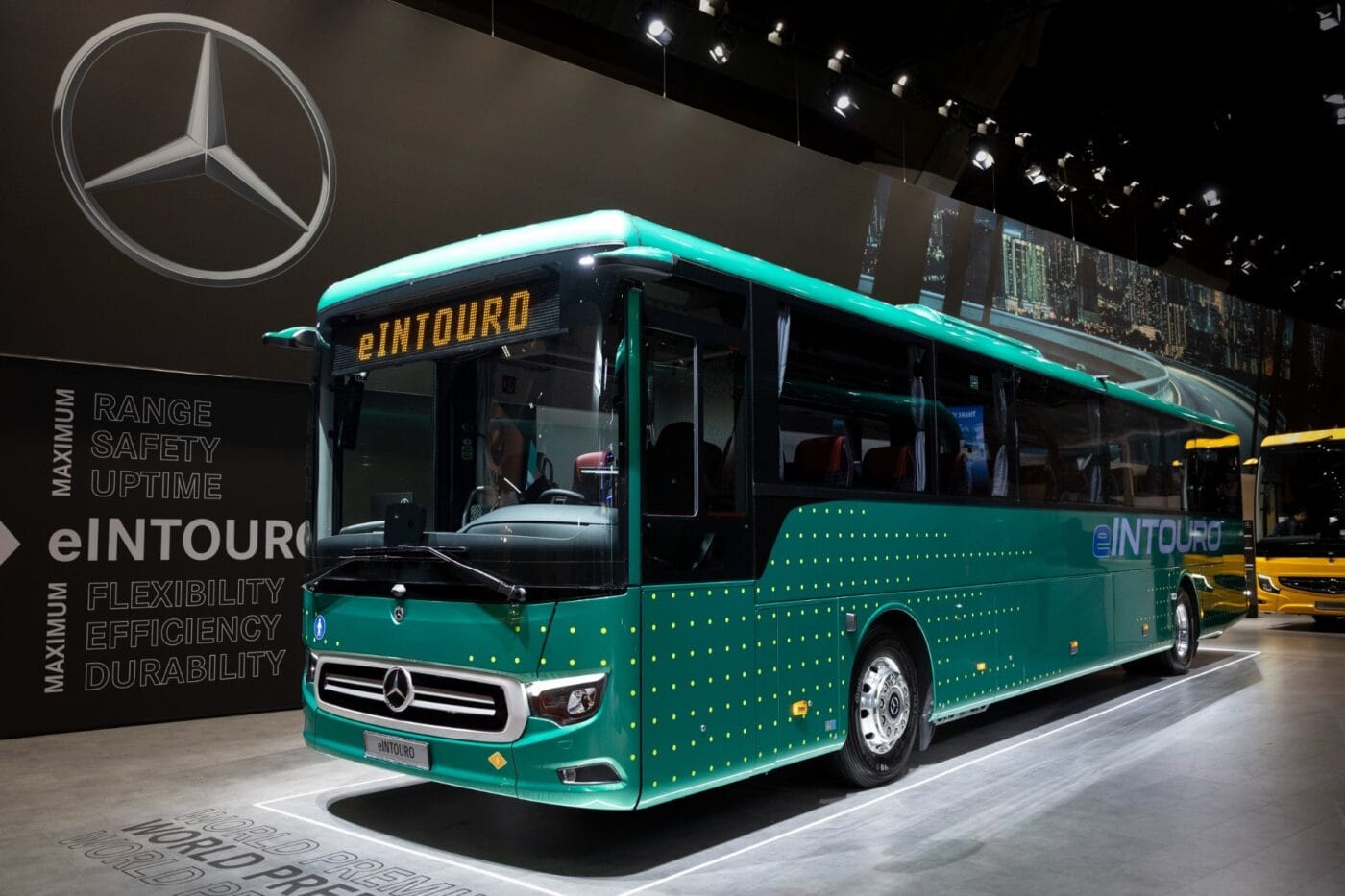
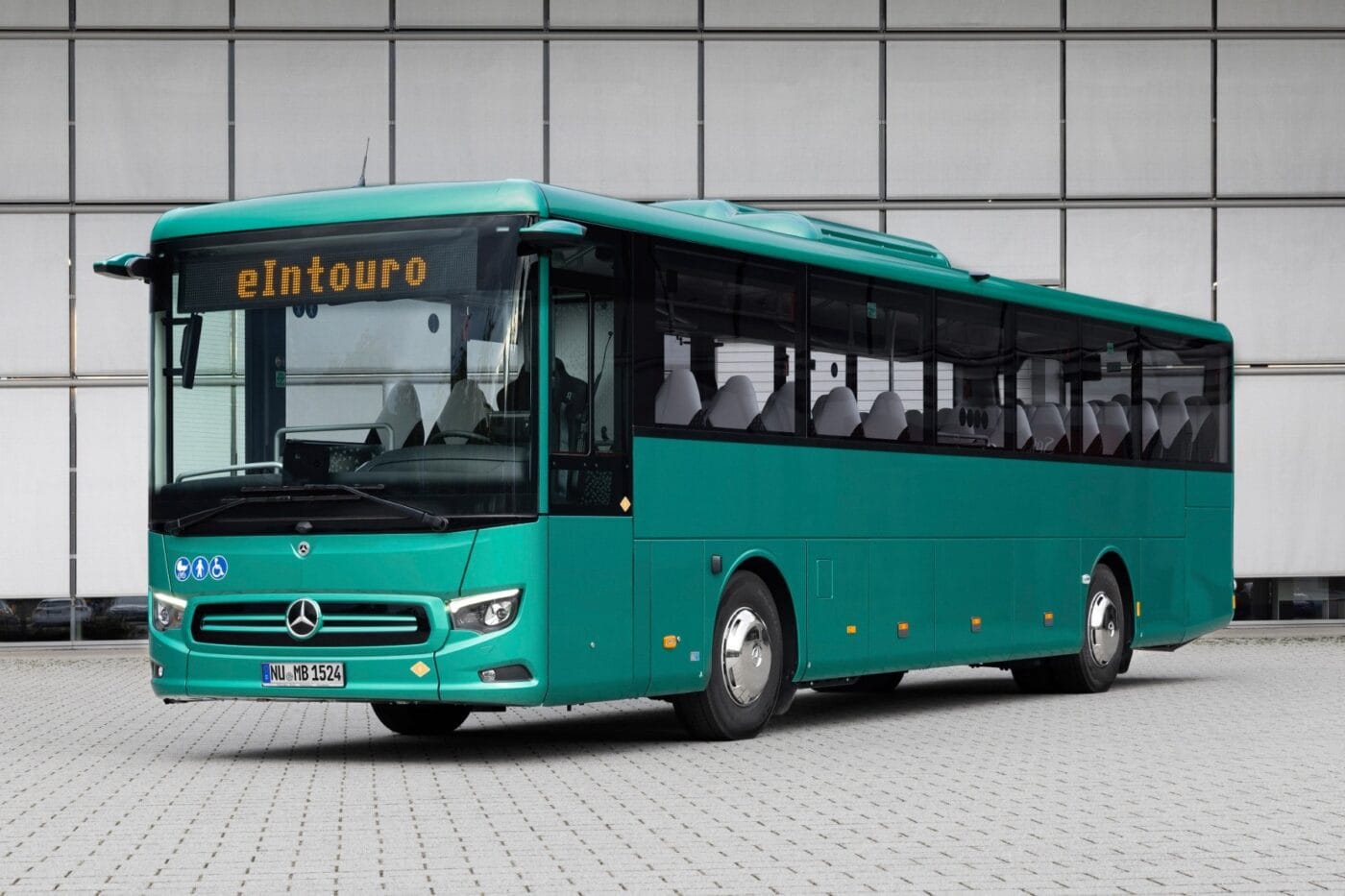
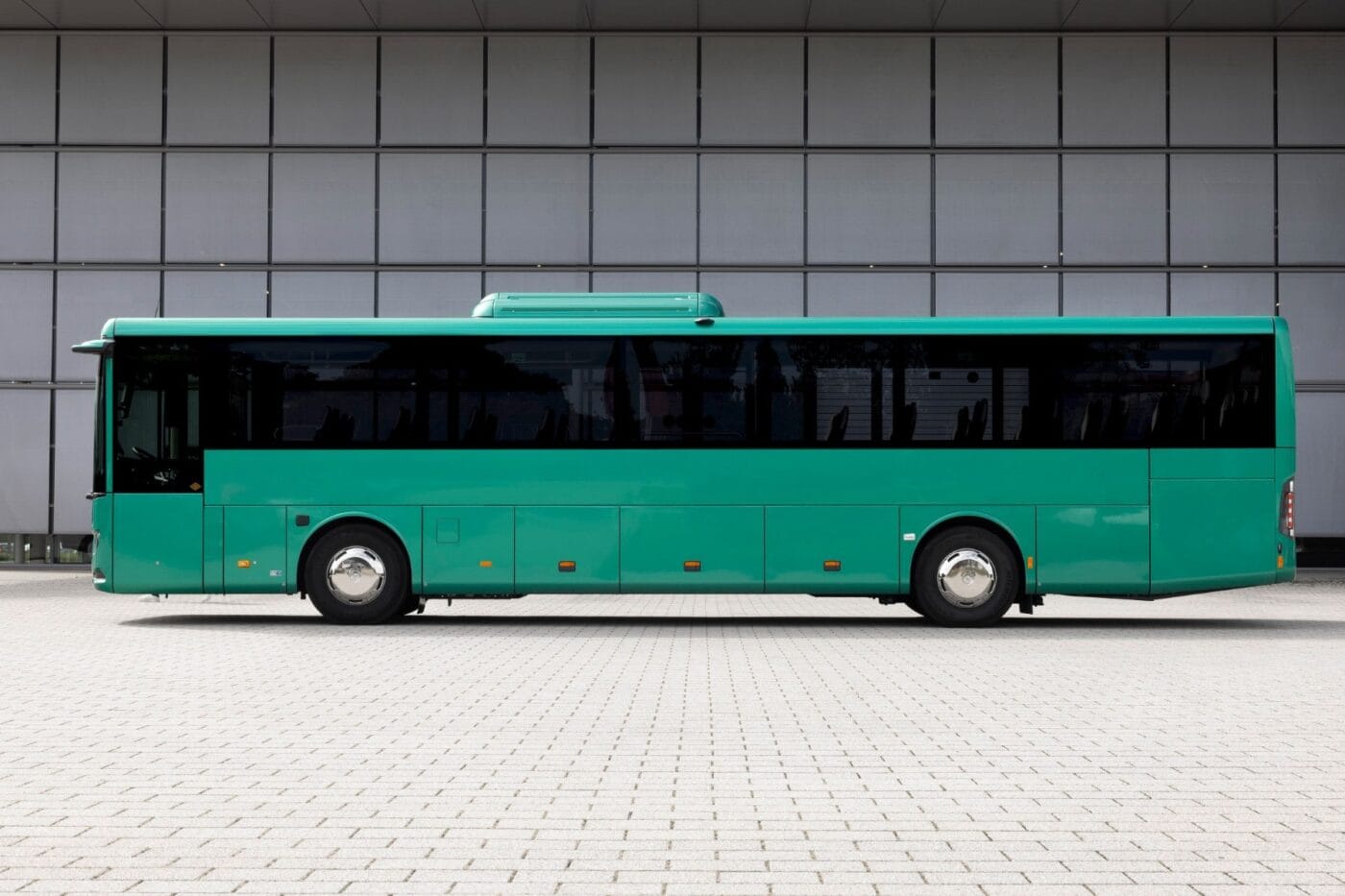
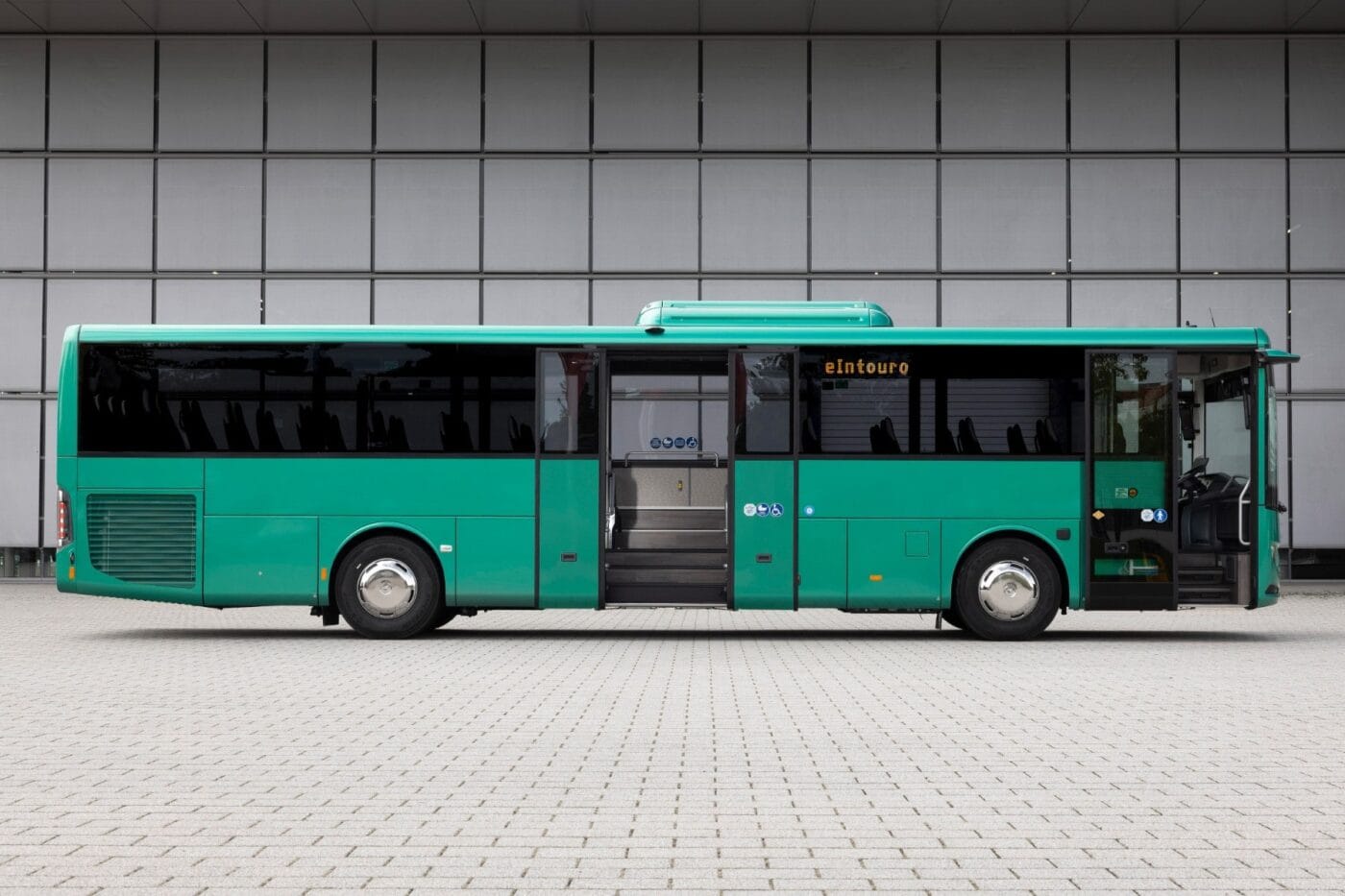
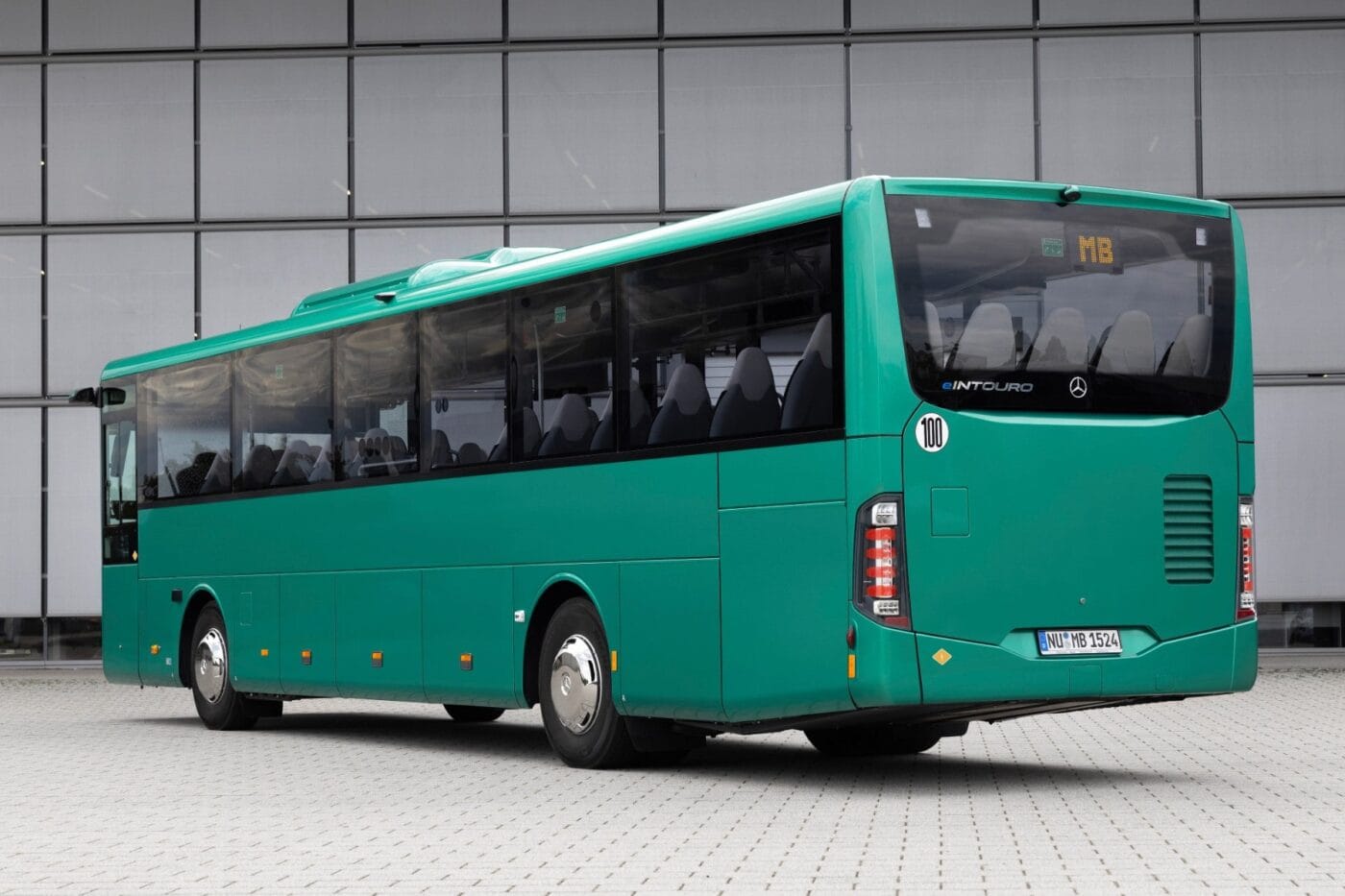
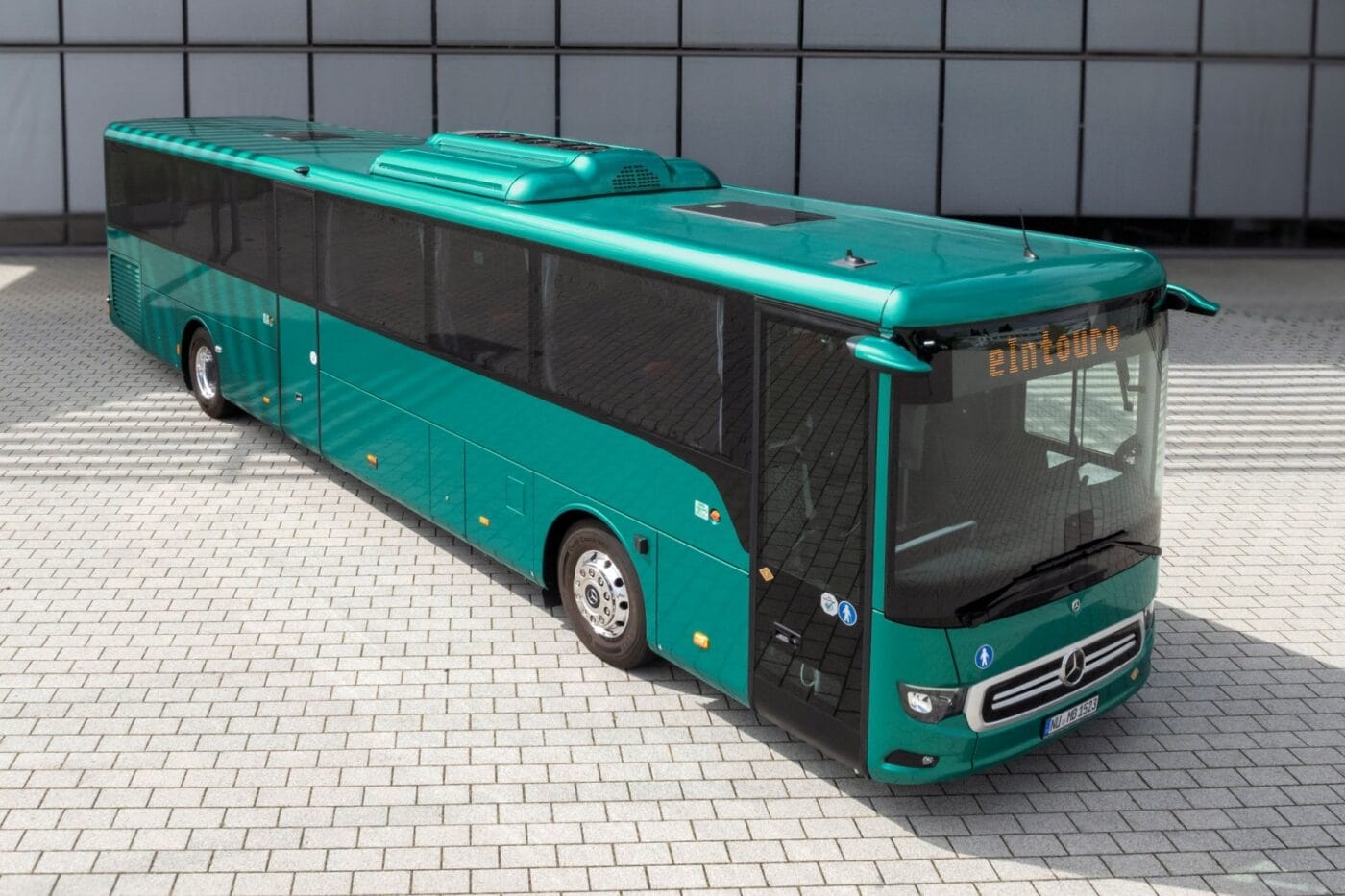
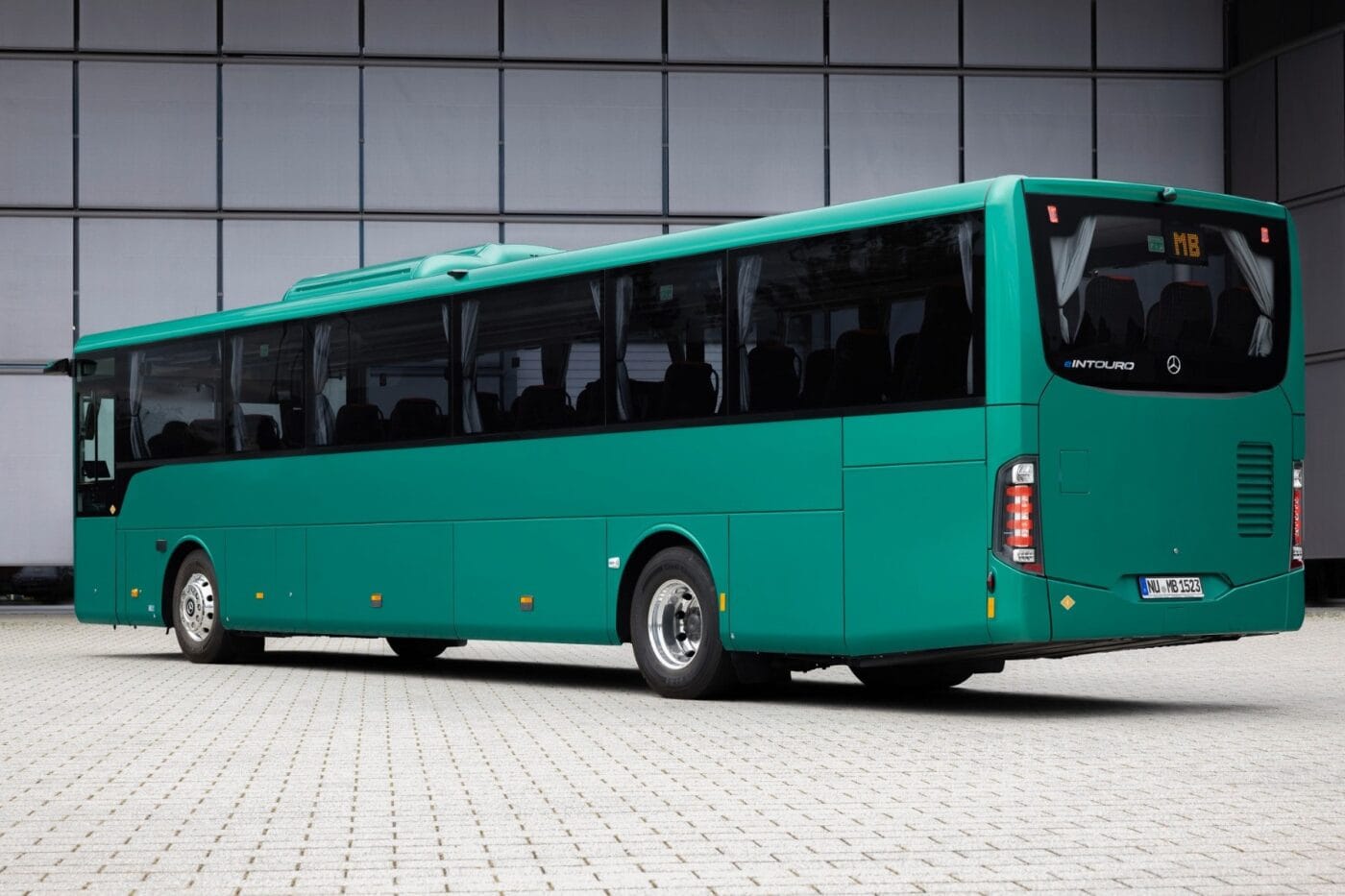
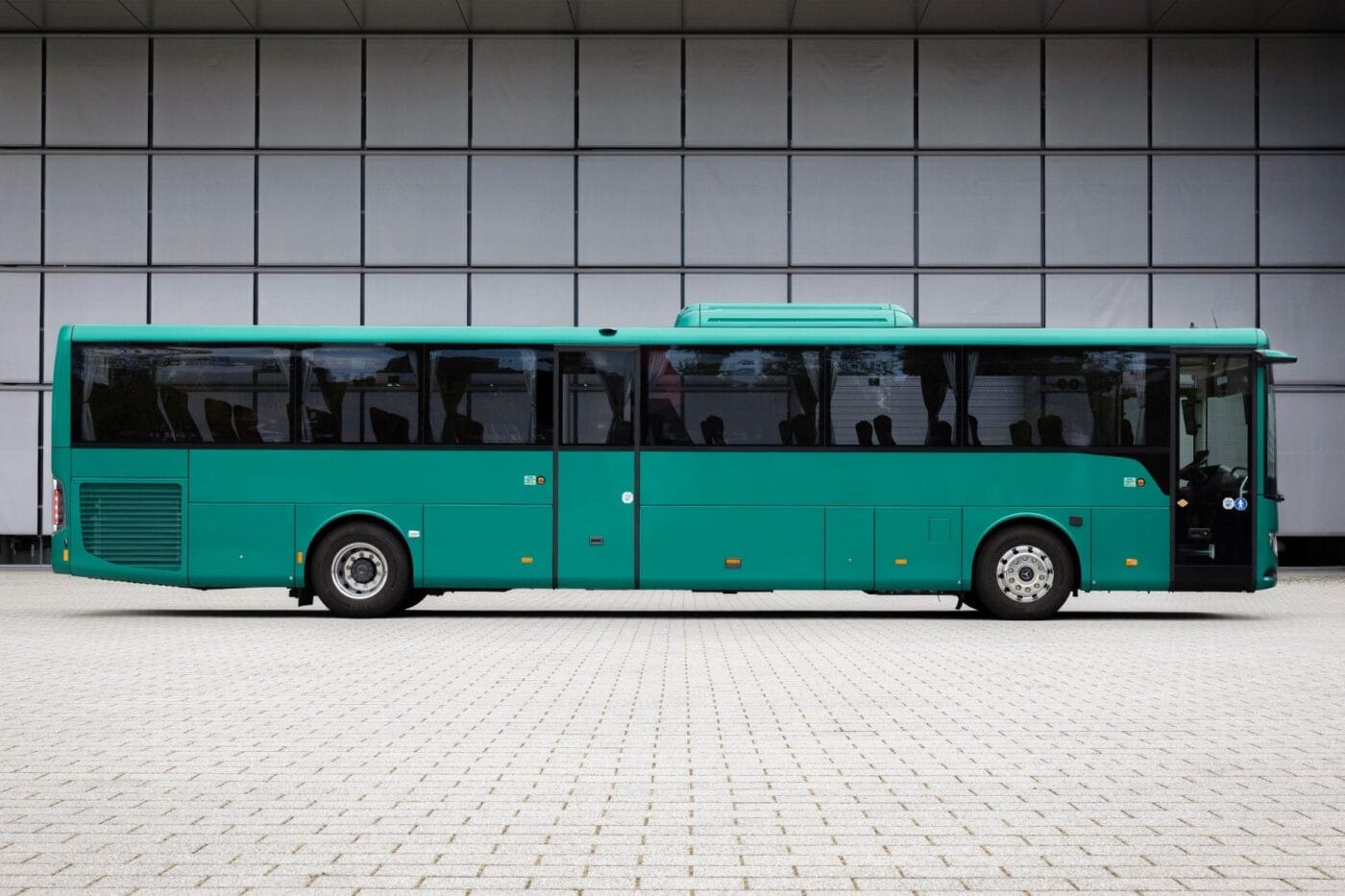
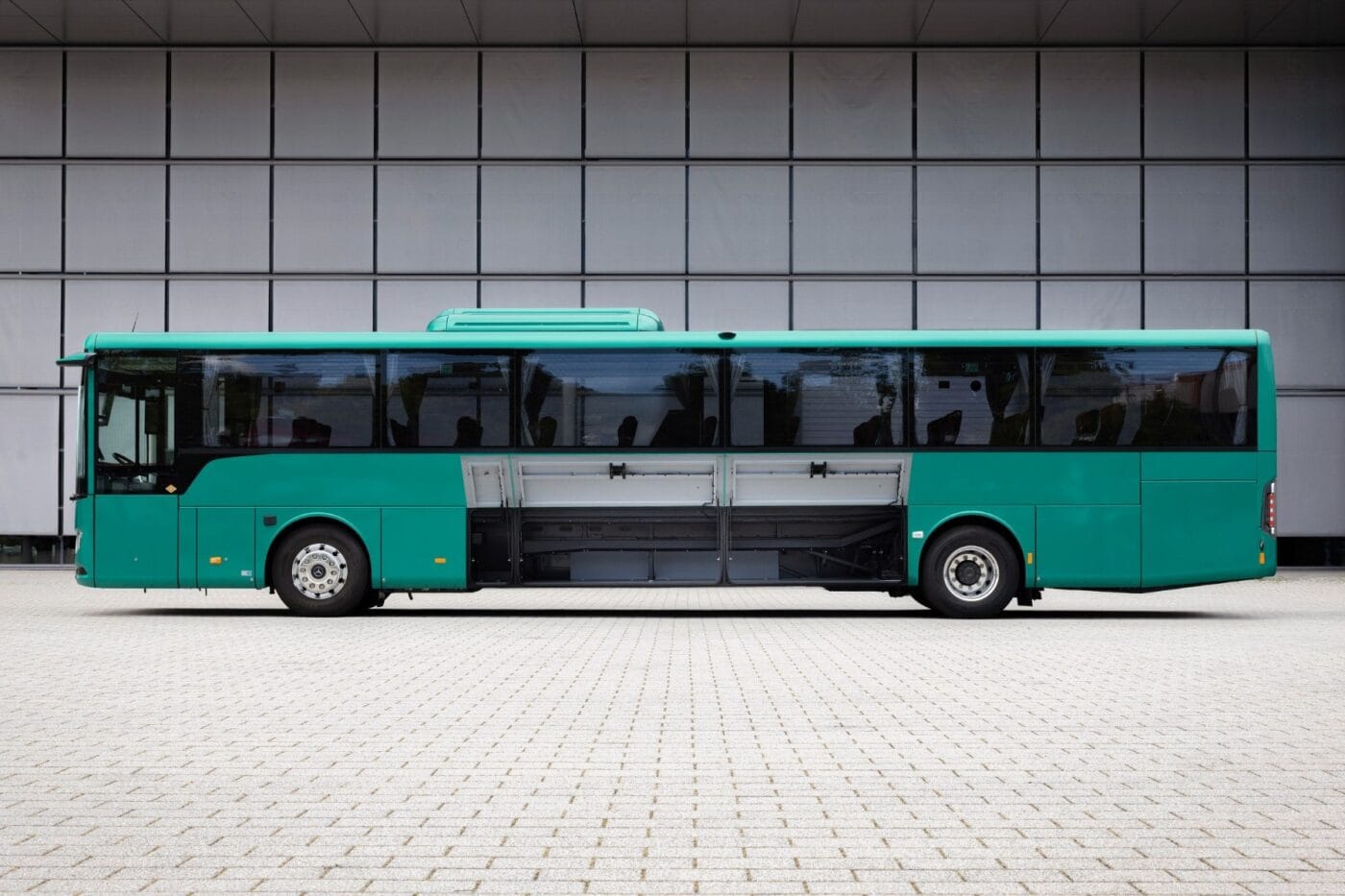
Since spring 2025 – prior to its unveiling – the vehicle has already been available to order. The first customer vehicles are now scheduled for delivery in the second half of 2026. Production will take place in Turkey and France at Daimler Buses’ Hosdere plant near Istanbul and at the factory in Ligny, France. Daimler Buses had already set out in its electric roadmap some time ago that an electric-powered intercity bus would be launched in the middle of the decade. According to this roadmap, BEV coaches are also set to follow by 2030, with H2 counterparts coming later.
Daimler Buses is also presenting the long-awaited new NMC4 battery generation for the eCitaro. In addition, shortly before the trade fair, the manufacturer made a public announcement that it intends to install its own public charging stations for electric coaches at highly frequented tourist locations in Europe from 2026 onwards. The project will start in Cologne.
While Daimler Buses continues to develop its electric coach, MAN has already ventured into this segment: the star of the show at the MAN stand this year was the three-axle BEV coach Lion’s Coach 14 E, which MAN is celebrating as the “first fully electric coach from a European manufacturer.” Production is scheduled to start in 2026 at the MAN plant in Ankara, Turkey. Initially, an ‘early fleet’ will be delivered to selected pioneer customers. Even before the unveiling in Brussels, MAN had announced the most important technical specifications for the new long-distance bus in May. Since then, it has become clear that although the Lion’s Coach diesel series forms the framework for the new XXL electric vehicle (dimensions: 13,968 x 2,550 x 3,885 mm), the drive system is based on the MAN eTruck, an electric truck from the company’s own stable.
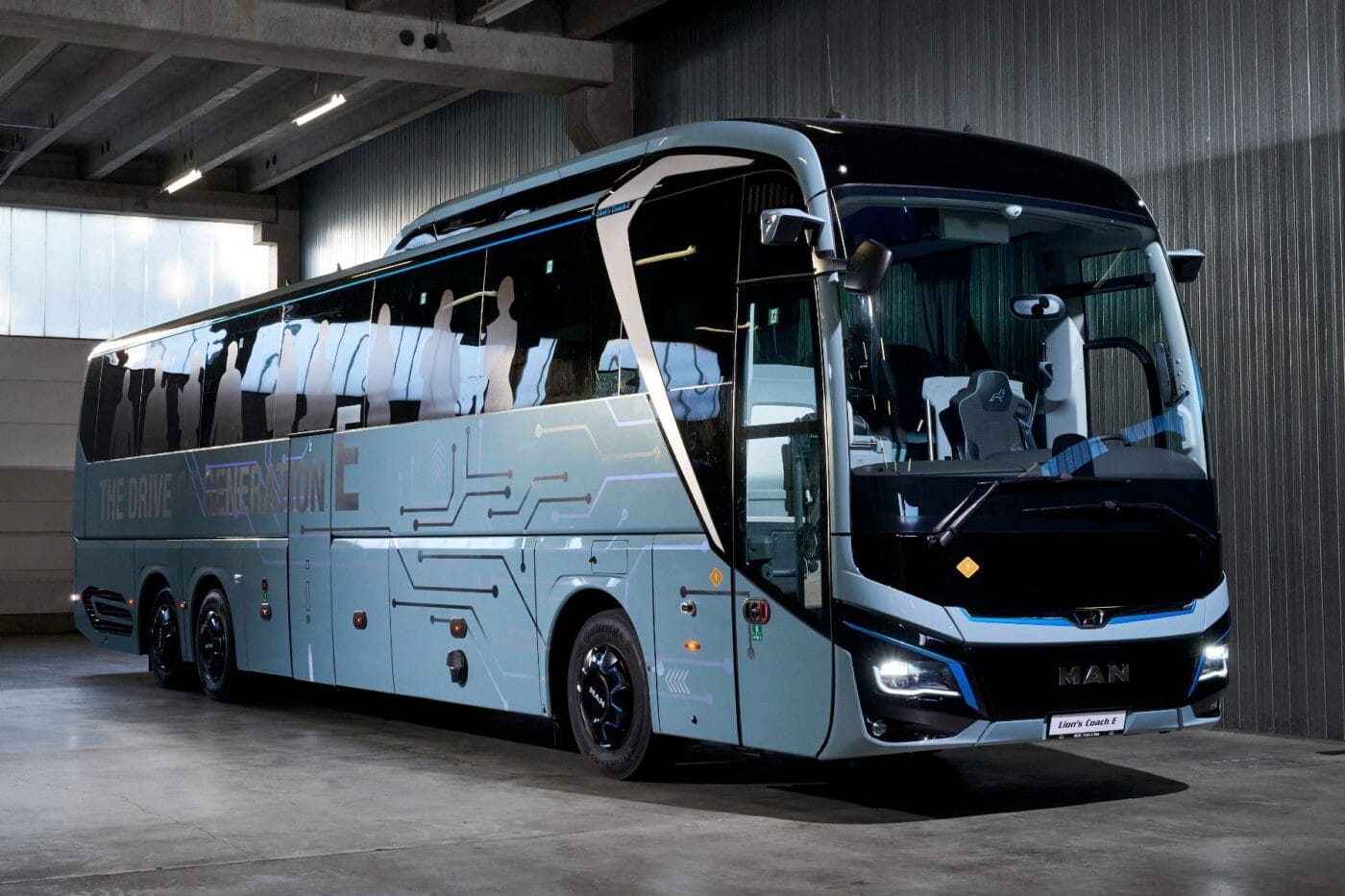
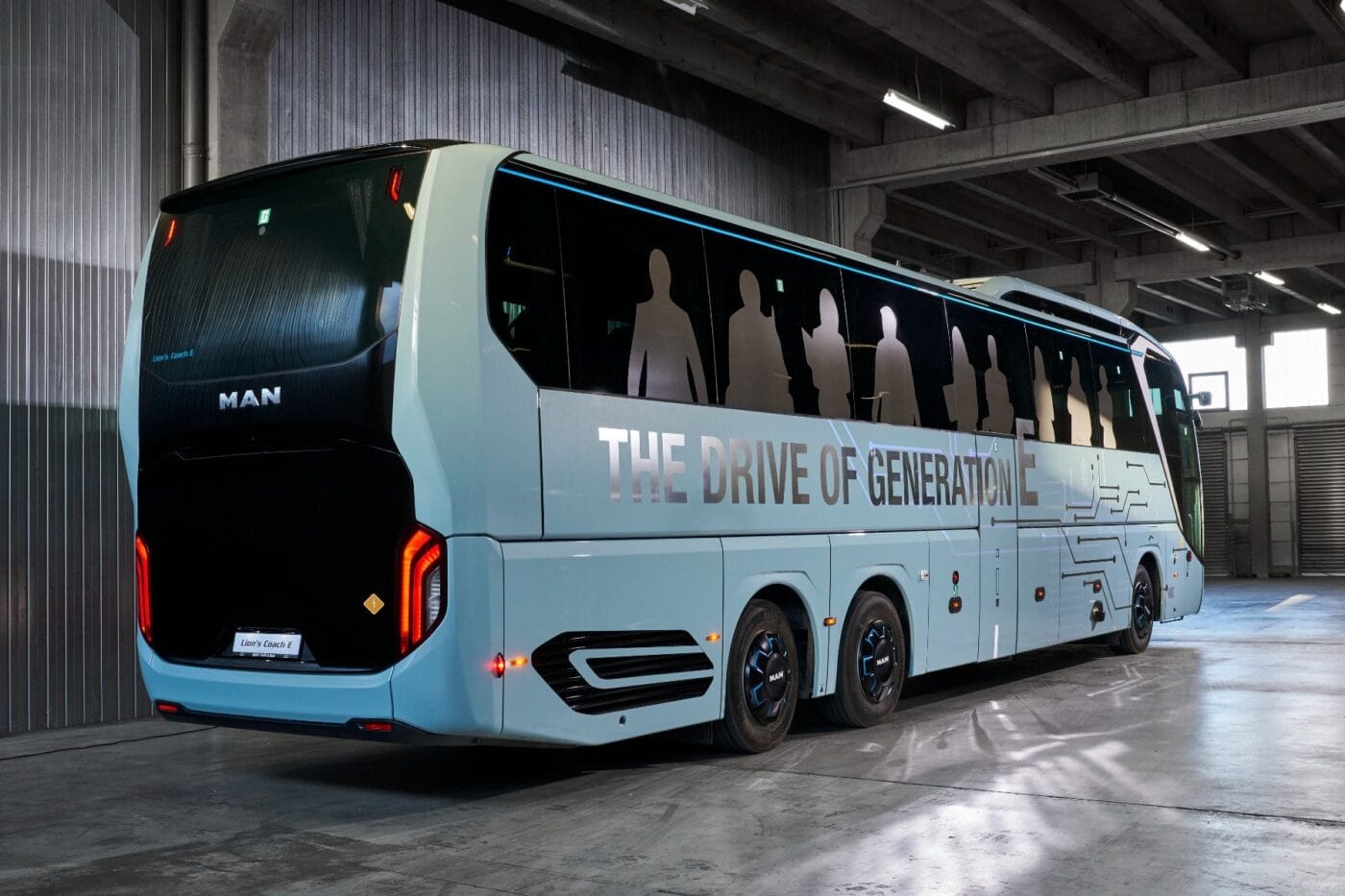
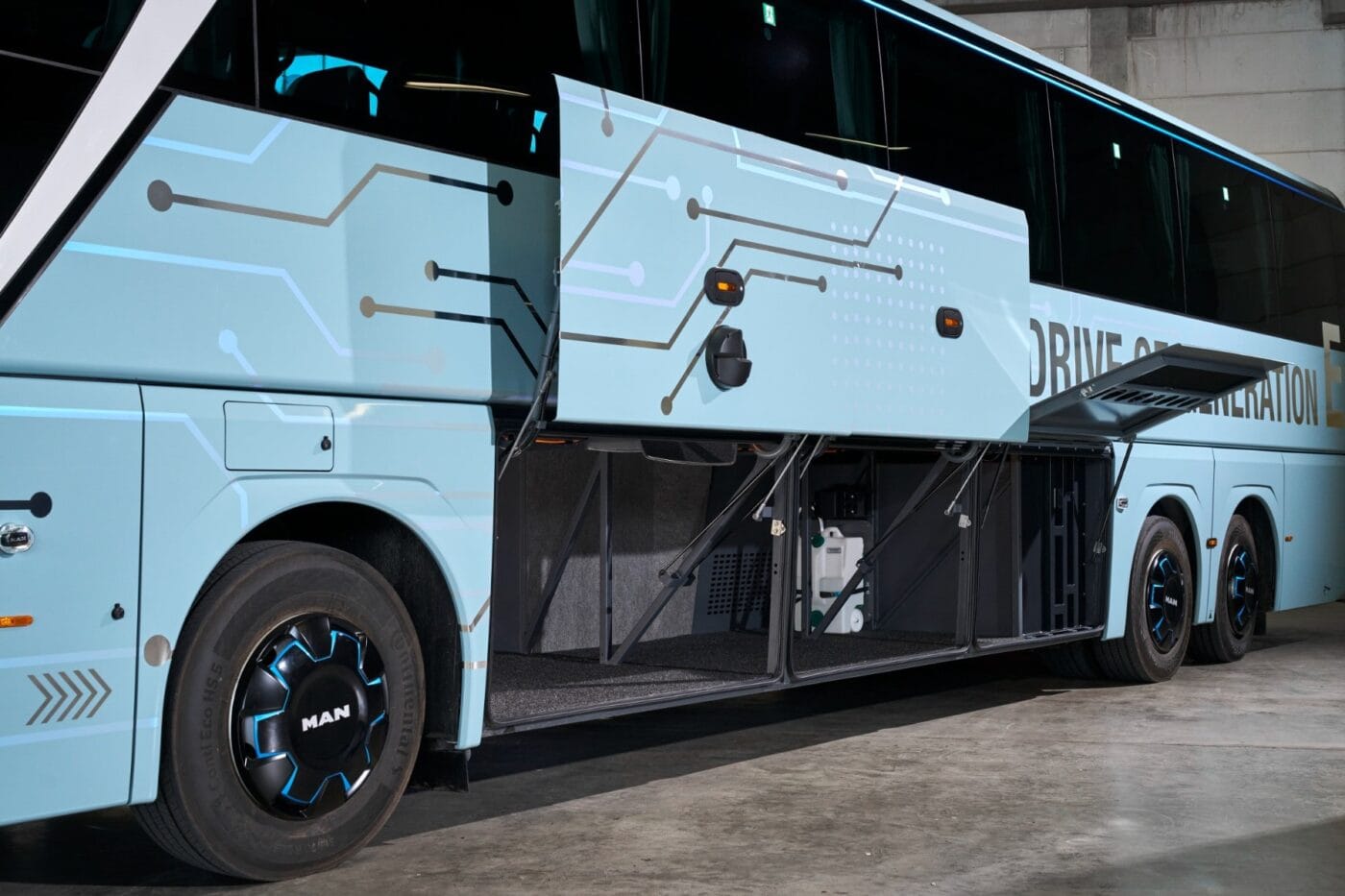
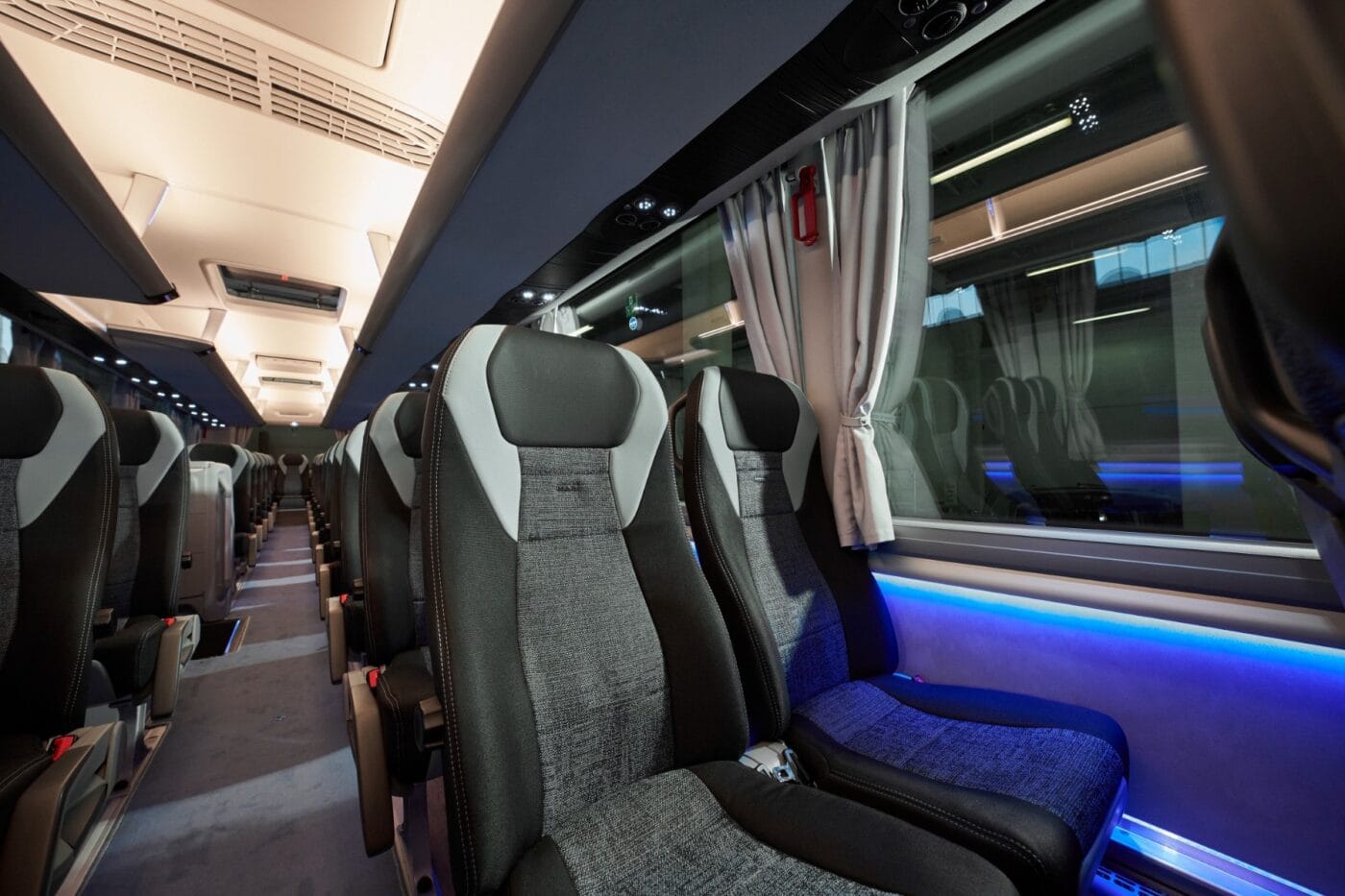
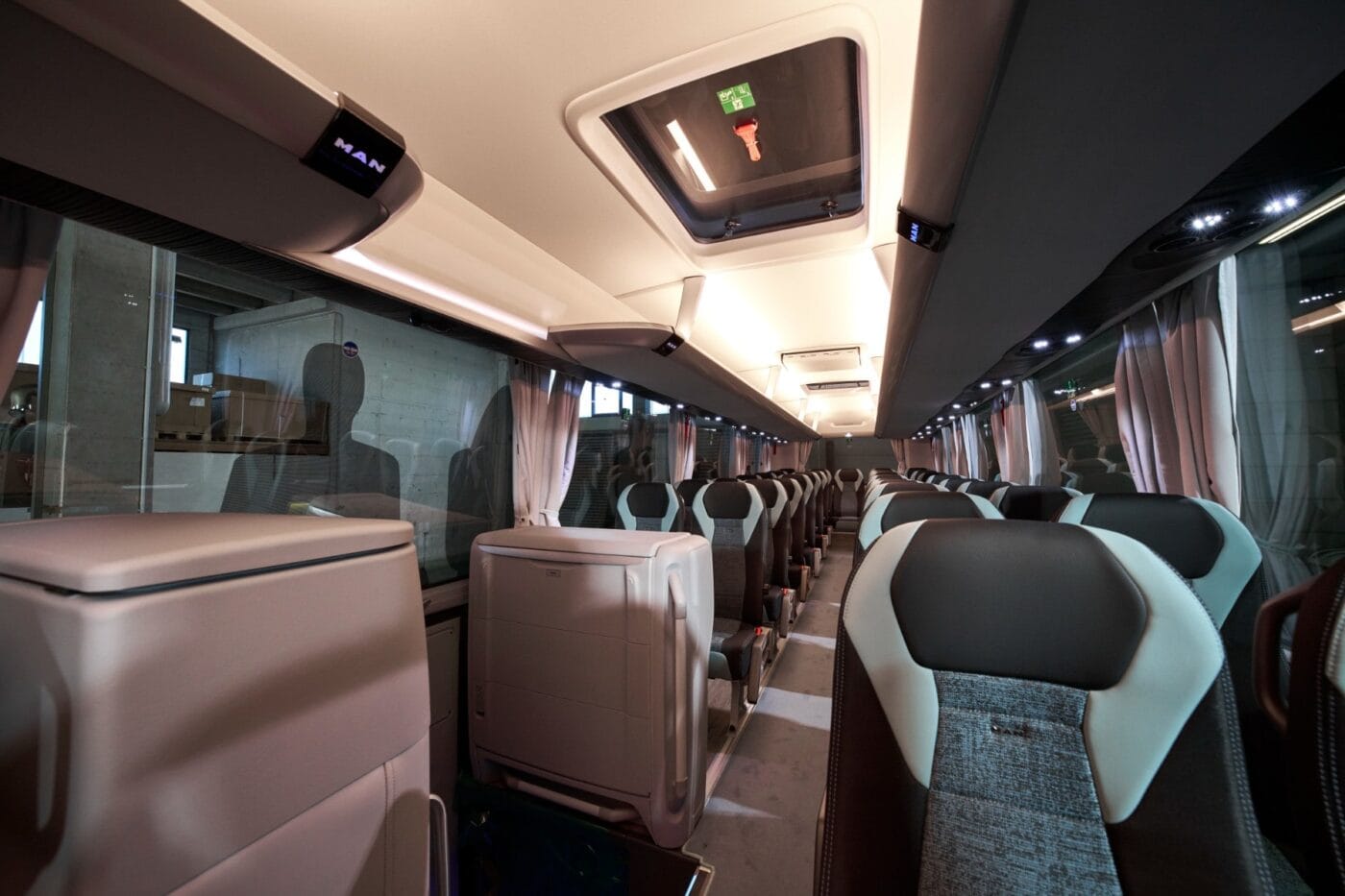
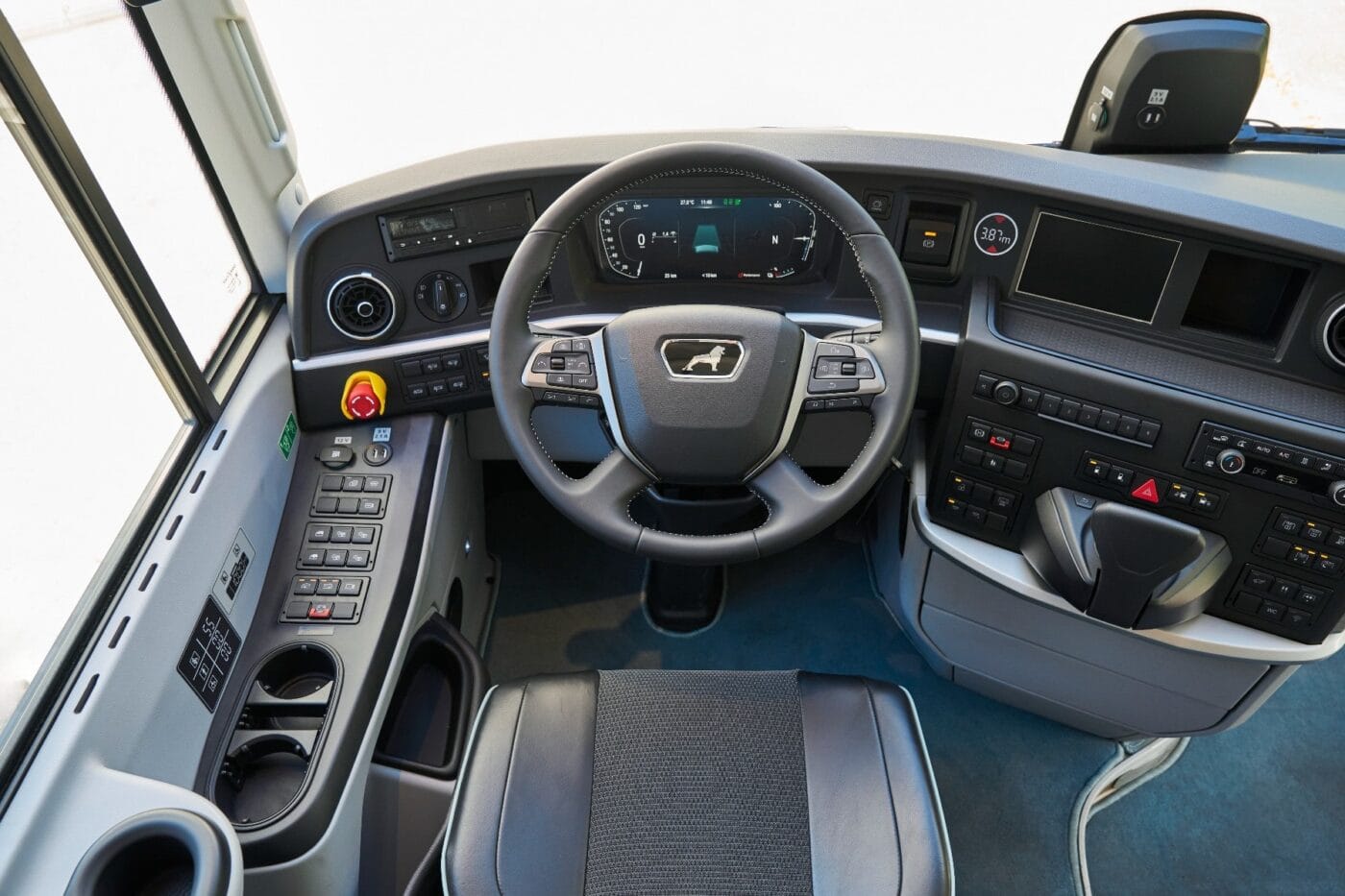
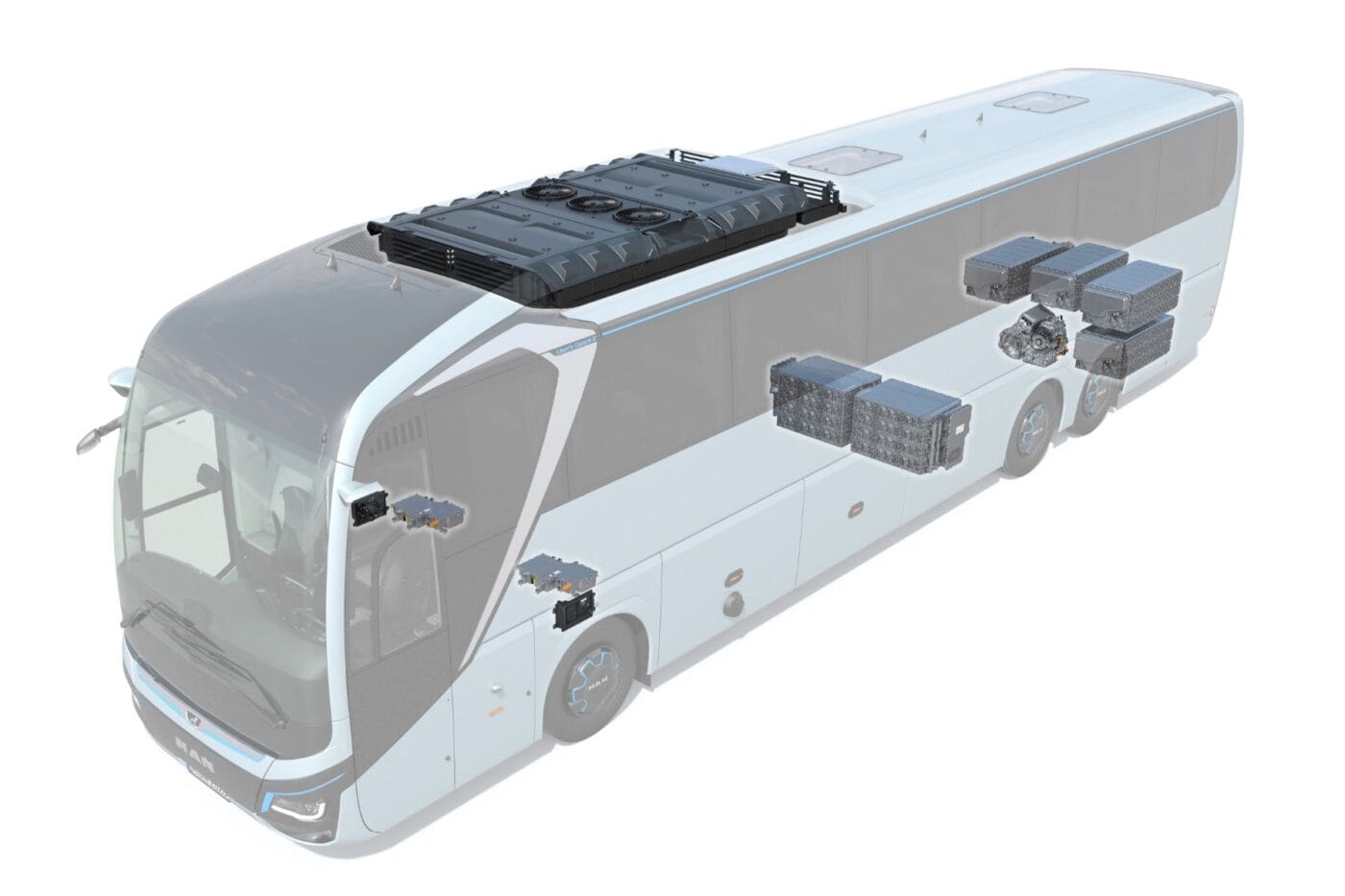
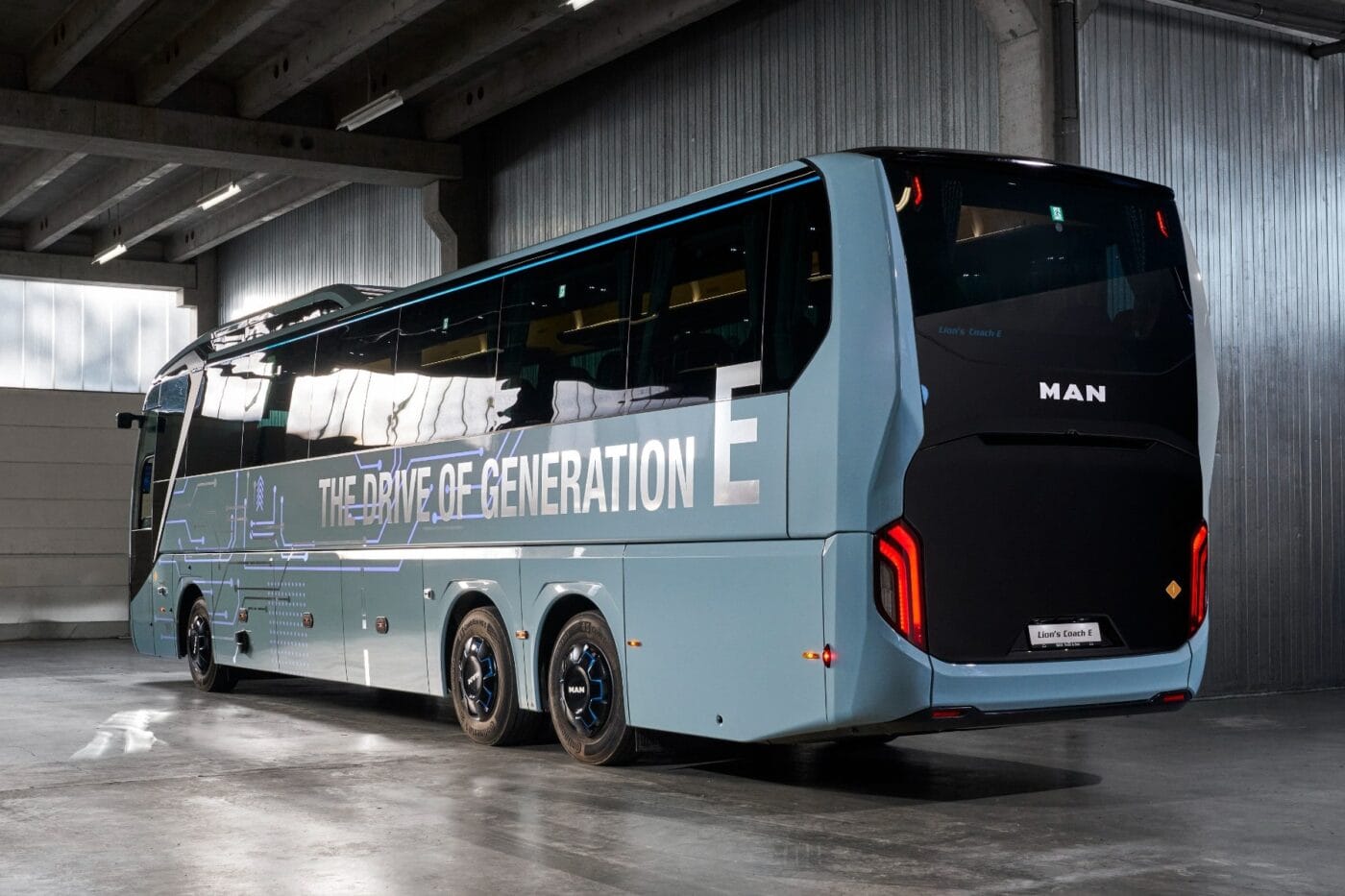
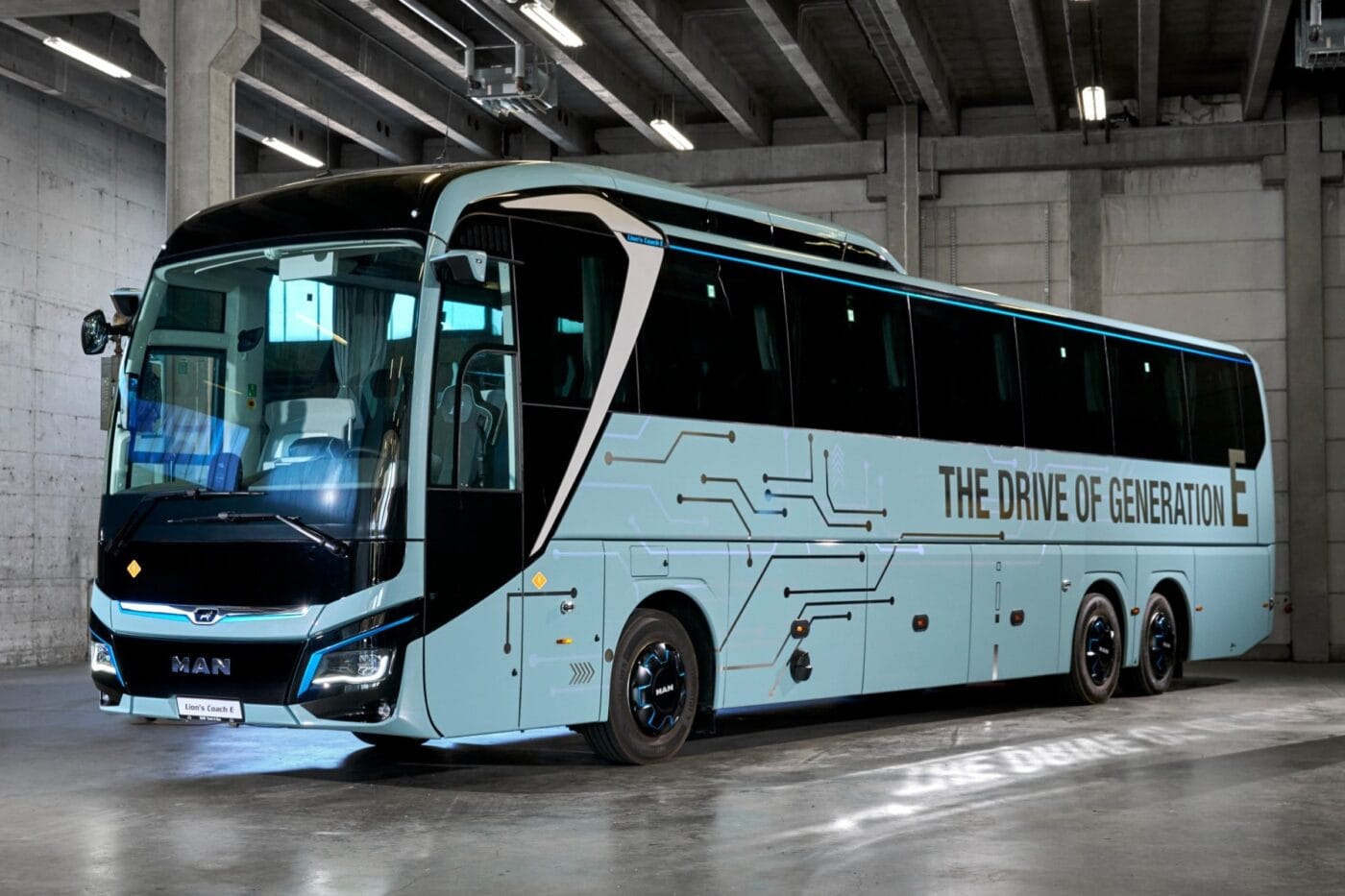
The Lion’s Coach 14 E uses the same 89 kWh battery packs as the truck, which can be charged via CCS with up to 375 kW DC and are mass-produced by MAN in Nuremberg. In the future, up to 750 kW will be possible via MCS (Megawatt Charging System), similar to MAN’s electric trucks. The coach can accommodate four to six battery packs (four as standard in the rear and one or two in front of the rear axle), which corresponds to a gross energy content of 356 to 534 kWh (up to 480 kWh usable). MAN estimates the range at up to 650 kilometres – thanks in part to the streamlined design (‘Smart Flow Design’), which brings the drag coefficient “into the range of compact SUVs,” according to the Munich headquarters.
The future electric coach will also inherit its motor from the electric MAN truck: MAN’s eCD330 synchronous motor with up to 330 kW of power. The central motor is located in the middle under the rear battery pack and is coupled with an automated four-speed gearbox. The packaging of the drive and battery components is to be so compact that there will be plenty of space available. MAN promises seating for up to 61 passengers and ‘no restrictions on luggage volume compared to its diesel counterpart’. Specifically, 11 to 13 cubic metres of space will be available.
By the end of the decade, MAN plans to roll out ‘more models in the coach segment in addition to the three-axle electric bus’. The manufacturer also cites ‘cost parity with diesel buses through lower energy, maintenance and repair costs’ as a medium-term goal.
The Munich-based company also brought along the Lion’s City 12 E LE electric city bus from the 2025 model year – this too is set to score points with a battery update.
Meanwhile, at the Scania stand, a new BEV platform for electric high-floor buses is attracting visitors’ attention. This platform can be used to build both city buses and long-distance coaches, with a focus on the latter. According to Scania: “The platform will be used in particular for the company’s battery-electric coaches and offers a range of up to 600 kilometres and luggage space that is almost equivalent to that of coaches with combustion engines.” In addition, the new platform is intended to be suitable for bus rapid transit systems or for shorter intercity journeys, school buses or sightseeing buses with lower luggage space requirements.
However, the technology itself is not exclusive: the on-board electric motor delivers up to 330 kW, while the installed energy capacity is up to 534 kWh (with 480 kWh of available energy). These figures are consistent with the MAN electric coach that has just been unveiled. This is hardly surprising, as Scania and MAN both belong to Traton. Scania is also marketing the platform to third parties, and one customer is already ready to go: CaetanoBus will base its BEV coach, called e.LEVANTE, on the Scania platform. The 14.3-metre-long three-axle vehicle is scheduled to go into series production in 2026.
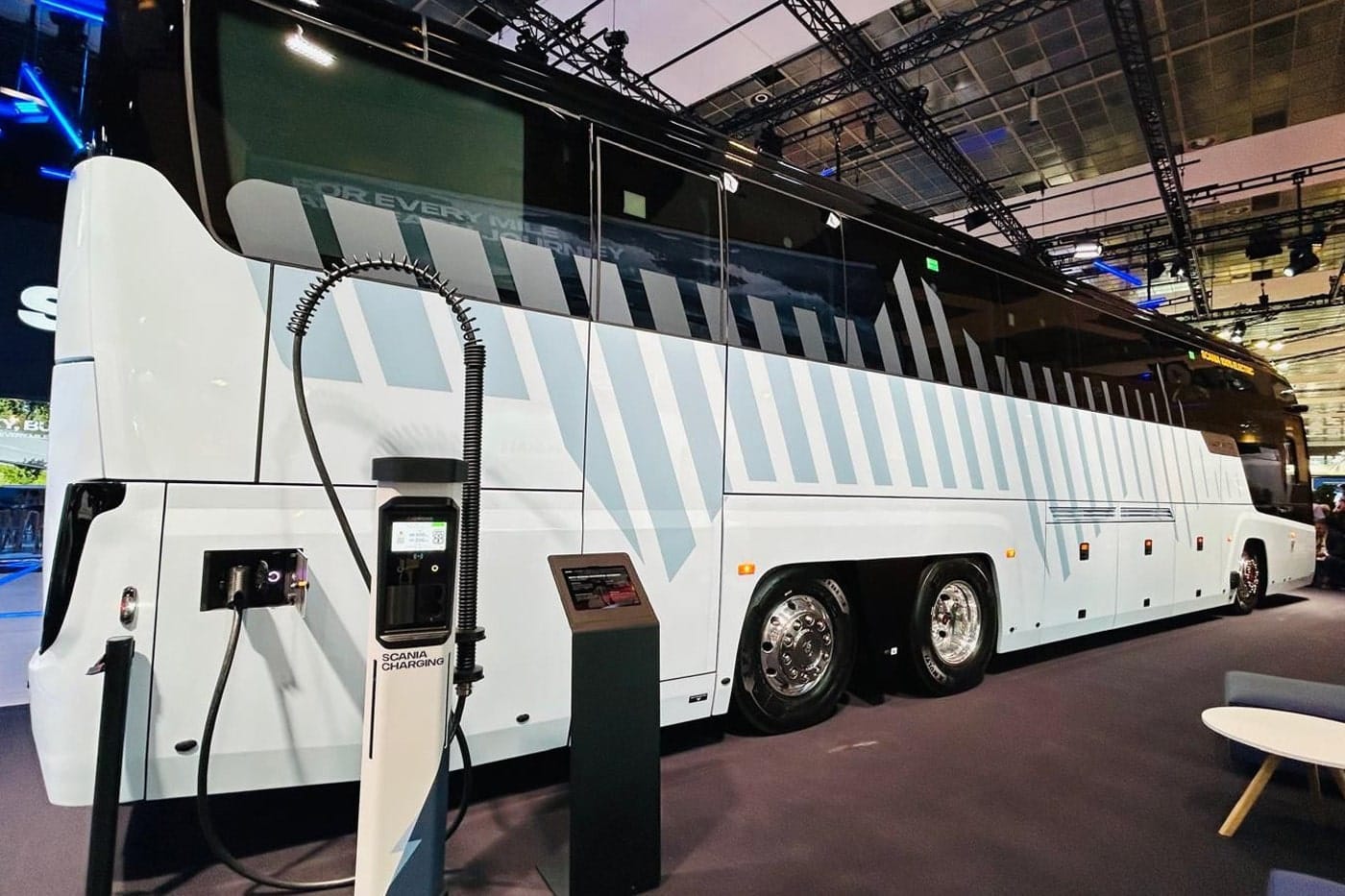
Irizar is also showcasing two new or redesigned electric buses. The Spanish manufacturer is putting the spotlight on a new offshoot of its Irizar i3 electric intercity bus – now with a normal floor instead of a low-entry design. The technology remains the same: available in two lengths (with a 528 or 716 kWh battery), the intercity bus is expected to have a range of more than 400 or 500 kilometres. The ie bus electric city bus is also being relaunched with a redesigned drive system and now bears the nickname ‘Efficient’. Incidentally, the new generation of the ie bus can also be registered for Class II, as an intercity bus.
The other electric buses for medium and long distances on display at the trade fair come almost exclusively from China, with well-known brands such as BYD and Yutong, but also relatively new players in this country, such as CRRC and Higer Bus.
BYD had several premieres to marvel at this year: The Chinese group showcased the B12.b BEV intercity bus and the B18.b electric low-floor articulated bus, both based on the newly unveiled e-Bus Platform 3.0 with 1,000-volt system voltage – and using blade batteries with LFP chemistry and wheel hub motors. Following the BYD eBus B12 and the BYD B13.b, both models are the manufacturer’s next electric buses to use the so-called Blade Battery Chassis platform. With this cell-to-chassis technology, the LFP battery is integrated directly into the vehicle structure.
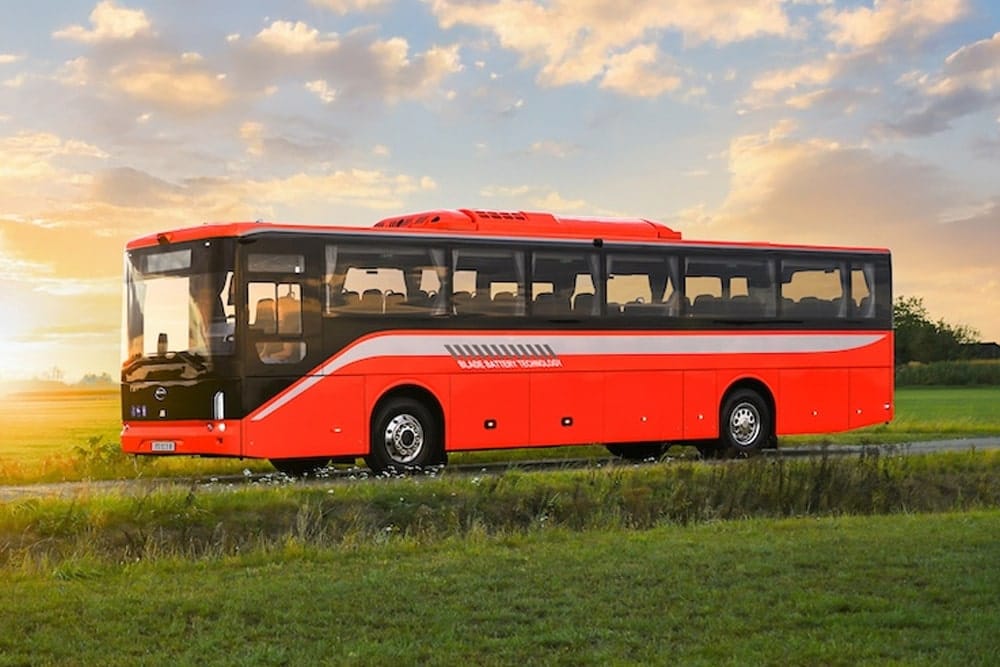
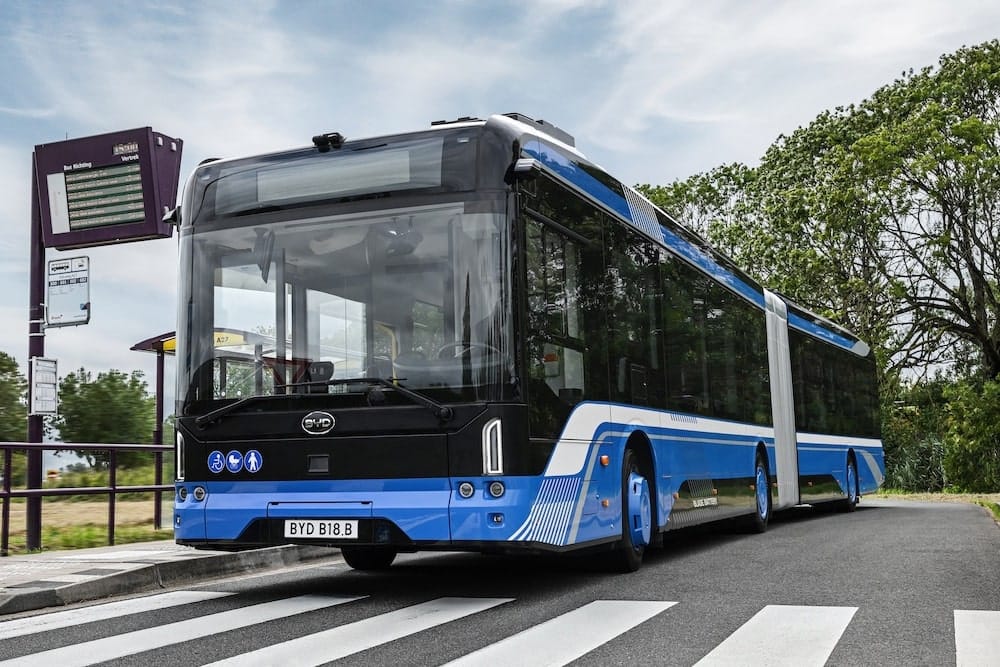
The eBus B12.b HF is a new high-floor bus for intercity routes that BYD has launched for European customers. The 12.1-metre-long intercity bus has a wheelbase of 5.95 metres and offers three battery sizes (311, 429 and 495 kWh) for a range of up to 650 kilometres according to SORT 3. The DC charging power is specified as up to 200 kW (plug) or up to 500 kW (pantograph). The bus is powered by two 150 kW wheel hub motors in combination with a new 6-in-1 controller with silicon carbide semiconductors. BYD estimates the luggage compartment volume at 5.7 cubic metres.
The eBus B18.b is an 18-metre-long articulated bus for urban transport – according to the data sheet, it can accommodate up to 146 passengers, has a maximum battery capacity of 746 kWh and a range of up to 630 kilometres. The charging capacity is stated as 300 kW (plug) or 600 kW (pantograph). What’s more, the B18.b offers optional all-wheel drive and features further selective improvements over the current generation.
BYD has announced that it now has more than 5,000 electric buses in operation in Europe – specifically in 160 cities in 26 European countries. In terms of service, more than 100 service locations are now said to have been opened in 15 European countries.
Next up are Yutong’s compatriots: With four new electric bus models alone, Yutong has one of the largest BEV ranges on display in Brussels. The Chinese manufacturer covers the entire spectrum of the electric bus market: the T14E is a coach designed for Europe, the IC12E is an intercity bus, and the U15 and U11DD are city buses.
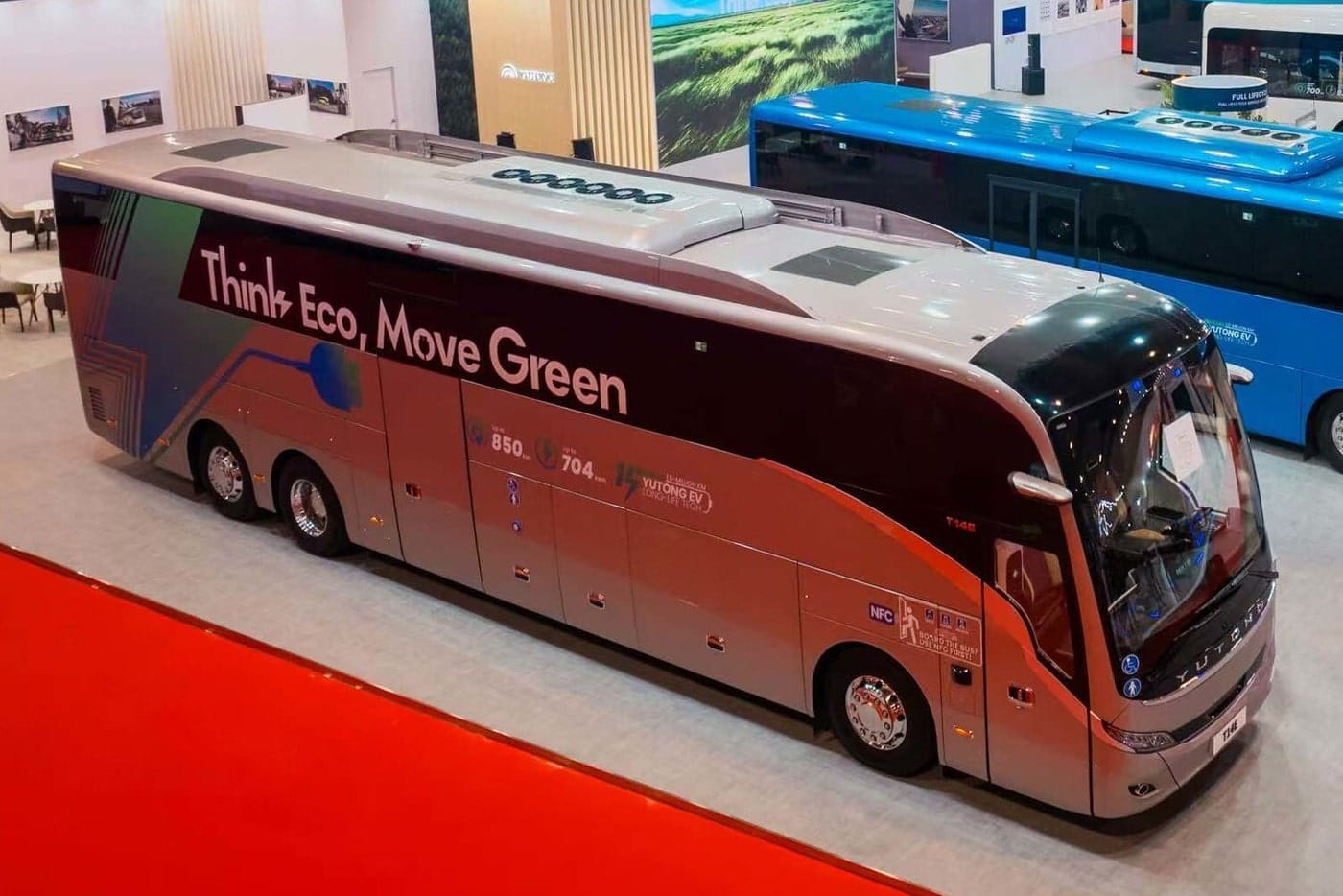
Yutong is positioning the 14-metre-long T14E as a luxury long-distance coach with a range of up to 850 kilometres (according to SORT3). Battery options include 621 or 704 kWh. The model is said to have 61 seats and an 8.5 cubic metre luggage compartment. The coach also features Continuous Damping Control (CDC) in combination with air suspension for intelligent adaptive chassis adjustments and a lifting device for passengers with disabilities.
The Yutong IC12E, which has also been adapted for Europe, is expected to have a maximum range of 675 kilometres (according to SORT2) as an intercity bus. The 12.66-metre-long vehicle has a high floor, 47 seats and numerous digital functions. The battery energy content on board is 466 kWh. The Chinese estimate the model’s consumption at 0.67 kWh/km under SORT2 conditions, and its climbing ability is 25 per cent.
Also worth mentioning is the U15, a 15-metre-long city bus which, according to Yutong, offers a maximum range of 850 kilometres (according to SORT2) and space for up to 90 passengers thanks to its 663 kWh battery. The manufacturer also put the spotlight on the eleven-metre-long U11DD electric double-decker (with 467 or 556 kWh battery capacity), along with its EnRoute+ service brand and Link+ fleet management system. Yutong now also operates a spare parts warehouse in France.
The Chinese manufacturer CRRC, which is still relatively unknown in the UK, is making a splash in Brussels with an electric bus designed specifically for tourist transport called the EU12C and the ED12 electric double-decker bus. The duo is being marketed by the China-based subsidiary CRRC Electric Vehicle Co. Ltd. The group intends to position the EU12C as a premium coach. It features 800-volt architecture, a peak power output of 480 kW and a torque of 5,100 Nm. The batteries with CATL cells are said to have a capacity of 441 kWh and can be charged with 350 kW DC, with a range of up to 550 kilometres.
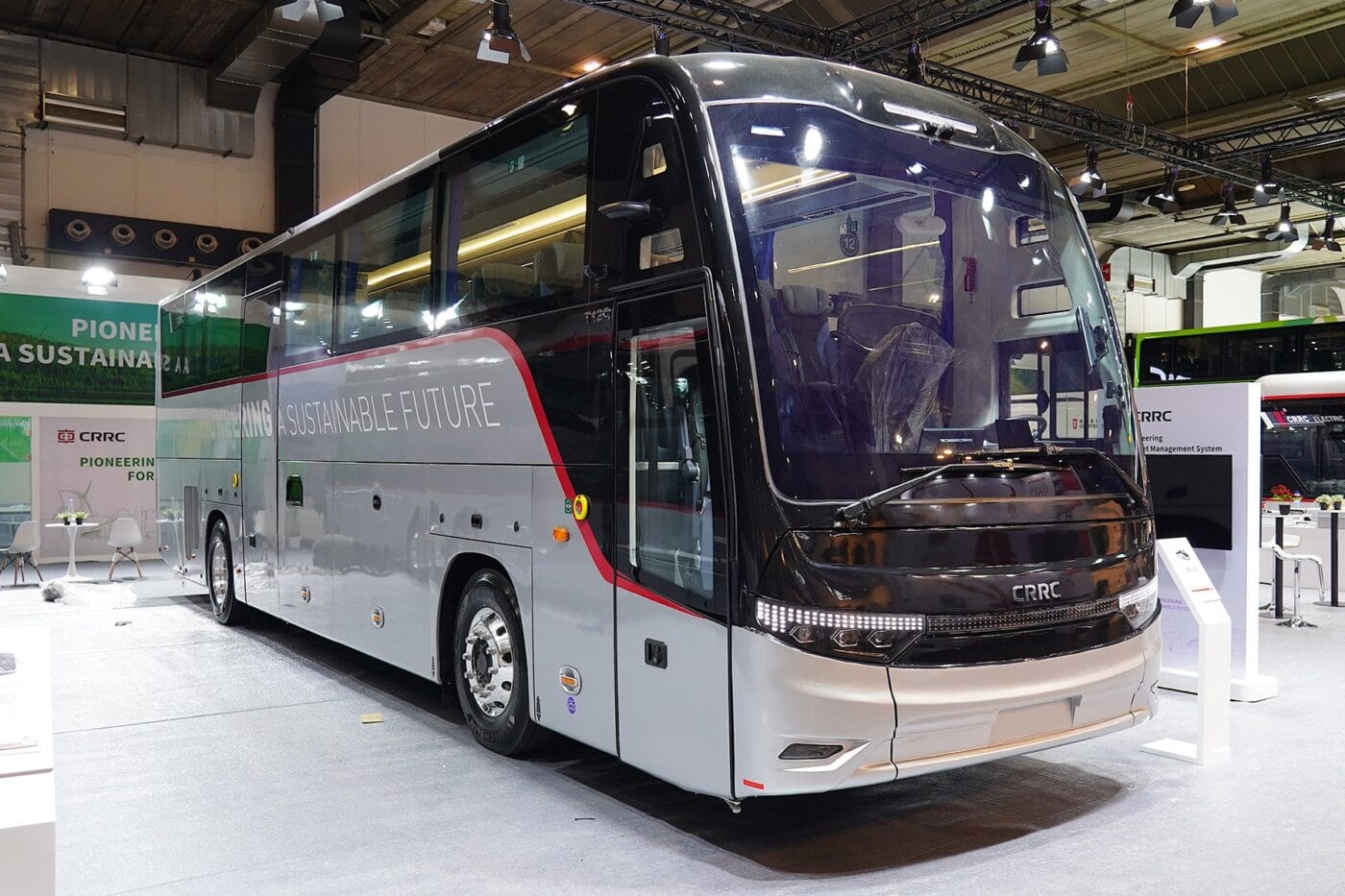
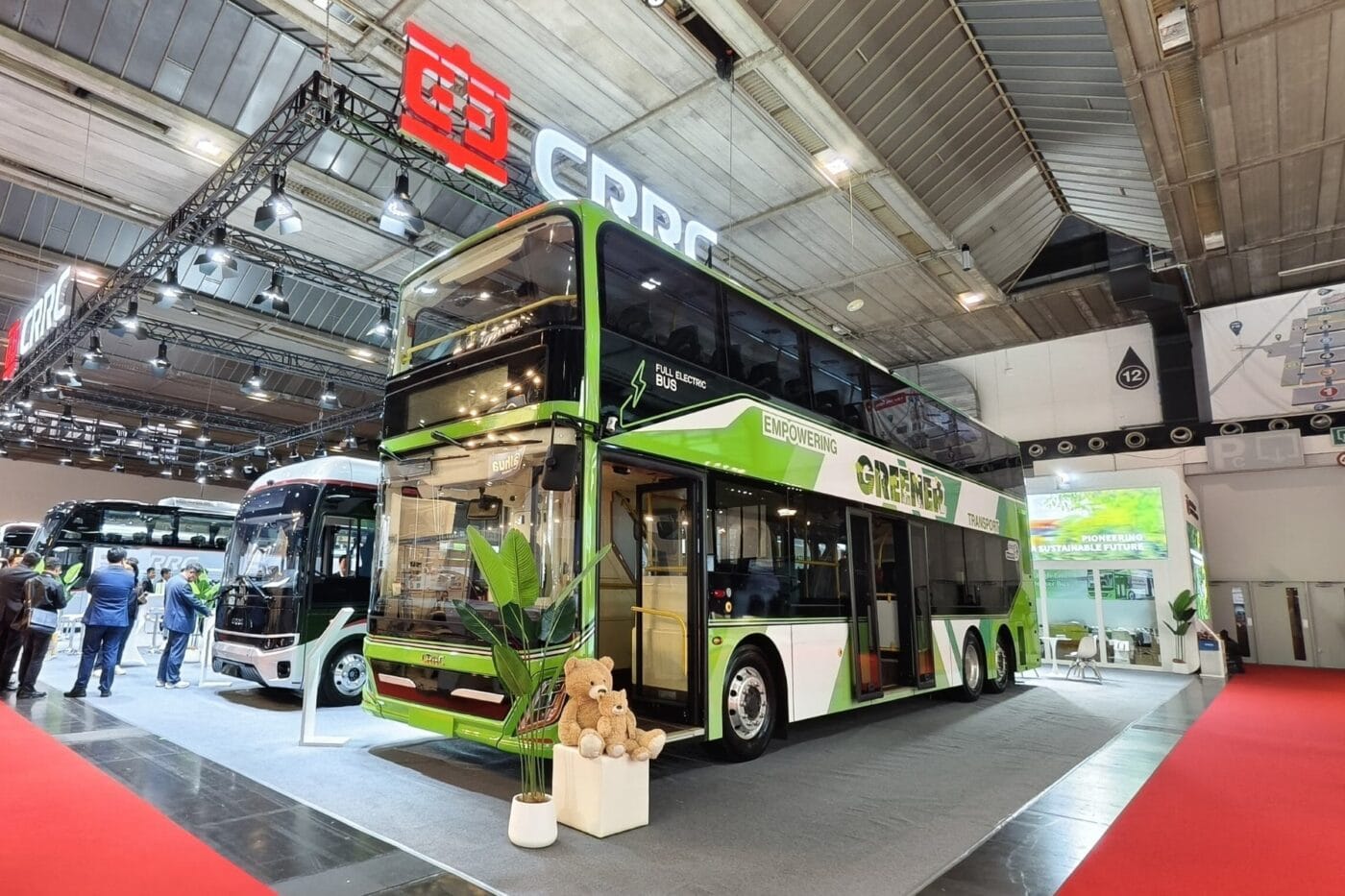
The ED12 electric double-decker bus is designed to carry 126 passengers and, according to E-SORT, has a range of up to 560 kilometres. Here, too, the drive system has a peak output of 480 kW. Incidentally, CRRC drive systems will also be found in Caetano buses in future.
Higer Bus is another Chinese player venturing into Europe with its BEV buses for intercity and coach travel. At the trade fair, the company is presenting its new V-series electric coaches for the European market: the V12E and V12E Pro. A few metres away, Higer Bus is also presenting the V13E electric intercity bus. The modular platform on which these vehicles are based covers vehicle lengths from 8 to 14 metres and various drive options. Higer is placing particular emphasis on an intelligent cockpit and premium equipment.
At the premiere in Brussels, the focus was therefore primarily on the V12E Pro, a 12.4-metre-long luxury coach with a nominal range of 500 kilometres. Higer Bus has not yet provided any details about the drive system, but instead emphasises the amenities in the form of sideways-sliding aisle seats, high-quality interior materials and integrated entertainment screens. The manufacturer estimates the size of the luggage compartment at over 10 cubic metres.
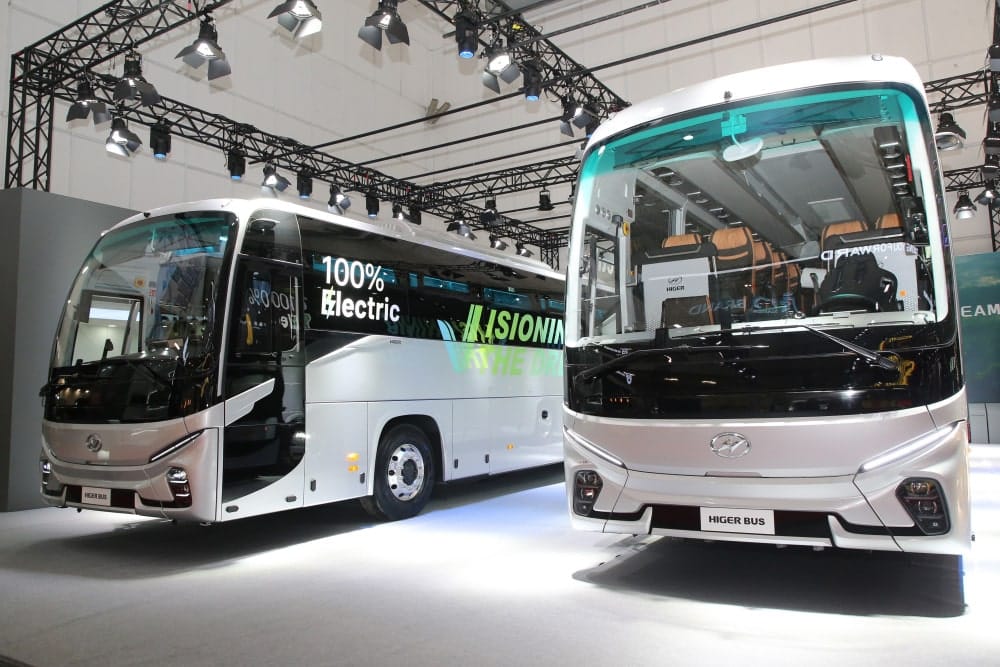
Information on the other two models is also still scarce. The V12E is also 12.4 metres long and is said to offer “an ideal balance between operational efficiency and passenger comfort.” The V13E is 13.15 metres long and is positioned in the intercity segment. The first V13E units are to be delivered to customers in France following the trade fair. It is also known that Higer Bus recently opened a spare parts centre in Luxembourg to strengthen its local after-sales and service network.
Higer Bus has been present in other regions of the world for some time: by 2024, vehicles with alternative drive systems are expected to account for around half of Higer Bus’s exports. The company now exports more buses than it sells domestically.
As further highlights of the trade fair, we have listed additional eMobility innovations for you here, by way of example and without claiming to be exhaustive:
- Solaris debuts Urbino 10.5 electric city bus
- VinFast presents EB 12 and EB 8 electric city buses
- Iveco celebrates the world premiere of the eDaily LE minibus
- Siemens presents its Sicharge Flex megawatt charging system
- Driventic, a Voith subsidiary currently being established, is showcasing its VEDS and VEDS 1.5 electric drive systems, among other things
- Ballard Power unveils a new-generation fuel cell module for public transport: the FCMove-SC
daimlertruck.com (eIntouro), daimlertruck.com, press.mantruckandbus.com, sustainable-bus.com, linkedin.com (beide BYD), bydeurope.com (BYD B12b), prnewswire.com (CRRC), en.higer.com, prnewswire.com (Yutong), irizar-emobility.com, irizar-emobility.com (Irizar ie Bus), irizar.com (Irizar i3), ivecogroup.com, scania.com, linkedin.com (Caetano)
This article was first published by Cora Werwitzke for electrive’s German edition


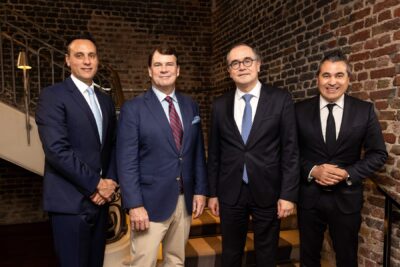
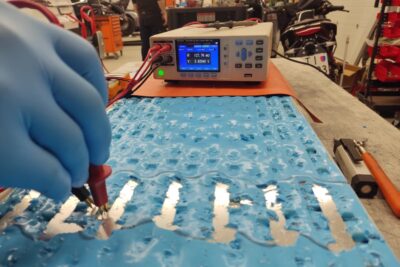
1 Comment